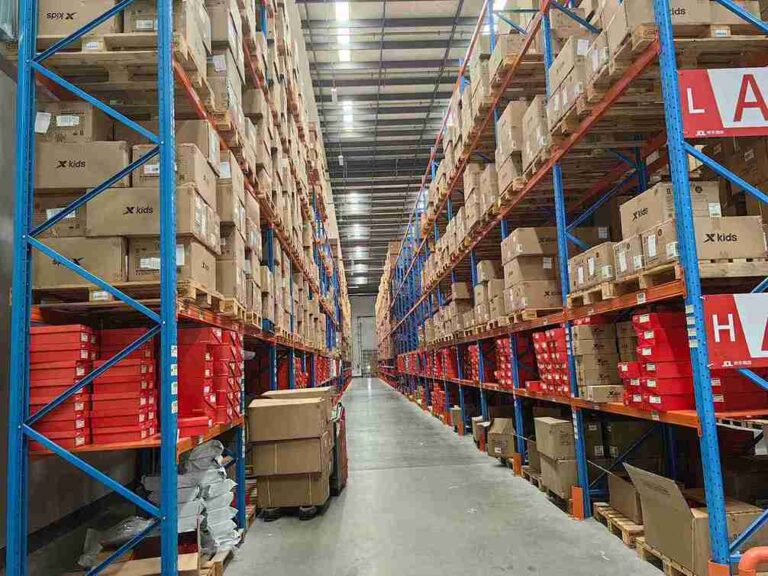📐 "First 50 Enterprise Queries Get Custom 3D Warehouse Design" Plan

Introduction: Why Warehouse Pallet Racking Layouts Make or Break Operations
A well-planned warehouse pallet racking layout is the foundation of an efficient, high-performing warehouse. Whether managing a small distribution center or a large-scale fulfillment hub, the right warehouse pallet racking layout directly impacts storage capacity, order fulfillment speed, and workplace safety. Poorly designed layouts lead to wasted space, slower operations, and increased risks of accidents.
This in-depth guide explores the best practices for warehouse pallet racking layouts, covering space optimization, load capacity planning, safety compliance, and future scalability. By implementing these strategies, businesses can maximize storage density, improve picking efficiency, and reduce operational costs—all while maintaining OSHA and RMI compliance.

H1: Critical Factors in Designing a High-Performance Warehouse Pallet Racking Layout
H2: 1. Analyzing Inventory for Optimal Warehouse Pallet Racking Layouts
Before selecting a warehouse pallet racking system, businesses must assess their inventory profile:
- SKU diversity – Do products vary in size, weight, and turnover rate?
- Picking frequency – Fast-moving items should be placed in ergonomic picking zones.
- Weight distribution – Heavy pallets require reinforced warehouse pallet racking beams.
H2: 2. Maximizing Storage Density in Warehouse Pallet Racking Layouts
To optimize warehouse pallet racking layouts, businesses must balance storage capacity with accessibility:
- Narrow aisle racking – Increases pallet storage density but requires specialized forklifts.
- Double-deep racking – Stores two pallets deep, reducing aisle space but limiting selectivity.
- Push-back racking – Uses a LIFO (Last-In, First-Out) system for high-density storage.
H2: 3. Selecting the Right Warehouse Pallet Racking System
Different warehouse pallet racking layouts serve distinct operational needs:
- Selective pallet racking – The most common system, allowing direct access to every pallet.
- Drive-in racking – Ideal for bulk storage of uniform SKUs with minimal selectivity.
- Cantilever racking – Best for long, bulky items like lumber, pipes, or furniture.
H1: Enhancing Workflow Efficiency in Warehouse Pallet Racking Layouts
H2: 4. Strategic Picking Methods for Faster Order Fulfillment
A well-structured warehouse pallet racking layout improves picking efficiency:
- Zone picking – Divides the warehouse into sections, reducing worker travel time.
- Batch picking – Groups multiple orders to minimize redundant trips.
- Wave picking – Combines batch and zone strategies for high-volume operations.
H2: 5. Smart Aisle Design for Seamless Material Flow
- Standard aisles (10-12 ft) accommodate traditional forklifts but reduce storage space.
- Narrow aisles (6-8 ft) maximize pallet storage density but require specialized equipment.
- Cross-aisle placement should align with high-traffic picking paths to minimize congestion.
H2: 6. Utilizing Vertical Space in Warehouse Pallet Racking Layouts
- Multi-tier racking leverages ceiling height for additional storage levels.
- Mezzanine floors create extra workspace without expanding the warehouse footprint.
H1: Safety & Compliance in Warehouse Pallet Racking Layouts
H2: 7. OSHA & RMI Standards for Safe Warehouse Pallet Racking
- Load capacity limits must be clearly marked and never exceeded.
- Column protectors prevent forklift damage to warehouse pallet racking uprights.
- Seismic bracing is essential in earthquake-prone regions.
H2: 8. Preventing Common Warehouse Pallet Racking Hazards
- Overloaded beams can collapse—always follow manufacturer weight ratings.
- Unsecured pallets may shift and fall, endangering workers.
- Poor lighting increases accident risks in narrow-aisle warehouse pallet racking layouts.
H1: Future-Proofing Warehouse Pallet Racking Layouts for Growth
H2: 9. Scalable Warehouse Pallet Racking Solutions
- Modular racking systems allow easy reconfiguration as business needs evolve.
- Adjustable beam heights accommodate changing product dimensions.
- Automation-ready layouts integrate with AS/RS (Automated Storage & Retrieval Systems).
H2: 10. Smart Technology Integration for Next-Gen Warehousing
- Warehouse Management Systems (WMS) optimize pallet placement in real time.
- RFID & barcode scanning enhances inventory tracking accuracy.
- AI-driven slotting dynamically adjusts warehouse pallet racking layouts based on demand.
Conclusion: Building a High-Efficiency Warehouse Pallet Racking Layout
A well-designed warehouse pallet racking layout is not a one-time setup but an evolving system that adapts to business growth. By implementing best practices—such as selecting the right racking system, optimizing picking workflows, and ensuring safety compliance—businesses can achieve higher storage density, faster order fulfillment, and lower operational costs.
Investing in a strategic warehouse pallet racking layout today ensures long-term efficiency, scalability, and workplace safety.
FAQs: Warehouse Pallet Racking Layout Optimization
1. How often should a warehouse pallet racking layout be reassessed?
We recommend reviewing warehouse pallet racking layouts annually or whenever inventory volume or business needs change significantly.
2. What’s the best warehouse pallet racking system for small warehouses?
Selective pallet racking is ideal for small warehouses due to its flexibility and direct pallet access.
3. How do I calculate aisle width for forklifts in warehouse pallet racking layouts?
Standard forklifts need 10-12 ft aisles, while narrow-aisle forklifts operate efficiently in 6-8 ft aisles.
4. Can different warehouse pallet racking systems be combined?
Yes! Many warehouses integrate selective racking, drive-in racks, and cantilever systems for diverse storage needs.
5. What’s the maximum height for warehouse pallet racking?
Most warehouses support 30-40 ft racking, but local building codes and forklift reach capabilities determine the limit.




